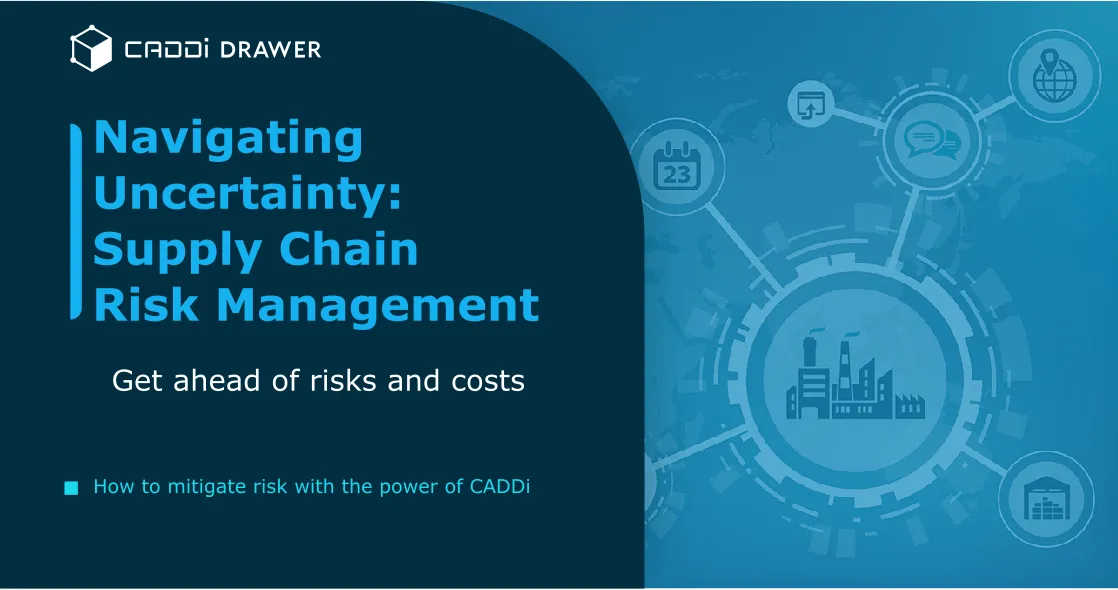Navigating the Inventory Whiplash Crisis: How Smart Data Management Can Steer Manufacturers Through Turbulence

Table of Contents

The American manufacturing sector is currently navigating a uniquely turbulent period, marked by what is being called the "Inventory Whiplash Crisis". This challenge is forcing manufacturers to rethink long-held strategies and adapt rapidly to an unpredictable environment. Understanding this crisis—what it means, why it has become such a pressing issue, and how innovative solutions like CADDi can provide a crucial lifeline—is essential for any manufacturer aiming to thrive in the coming years.
What is the Inventory Whiplash Crisis?
At its core, the Inventory Whiplash Crisis describes a severe cash flow and operational predicament for manufacturers. It arises when companies find themselves holding a large volume of high-cost inventory at the precise moment that organic demand is weakening. This is not a typical market fluctuation but rather a unique phenomenon driven by policy rather than consumer behavior, often referred to as a "tariff bullwhip" effect.
This "whiplash" unfolds in two distinct phases:
- Phase 1: The Great Front-Loading: In anticipation of new tariff implementations and potential escalations, manufacturers across the U.S. engaged in a massive, coordinated stockpiling effort, particularly throughout the second quarter of 2025 and into July. This defensive measure aimed to secure inventory before costs inflated, leading to significant surges in imports—for instance, U.S. containerized imports in July were more than 18% higher than the previous month. Sectors with deep global supply chain ties, such as automotive, industrial machinery, and metals processing, were especially active in rushing to convert raw materials into products before tariffs took effect.
- Phase 2: The Sudden Pullback: Following this period of aggressive stockpiling, there has been a sharp and sudden reduction in purchasing. Firms are now actively attempting to draw down the very inventories they spent months accumulating. This dramatic artificial drop in purchasing is colliding directly with weakening organic demand signals, leading to the crisis.
Why Has This Whiplash or Bullwhip Crisis Become a Recent Issue for American Manufacturers?
Several interconnected factors have converged to create and exacerbate this inventory whiplash:
- The Tariff Tsunami: A new and aggressive tariff regime implemented in 2025 has created unprecedented volatility. This includes a broad 10% tariff on goods from most countries, higher reciprocal tariffs, and steep duties on specific industrial inputs like a 50% tariff on steel, aluminum, and copper imports. This has resulted in the average U.S. tariff rate climbing to a multi-decade high, estimated between 16.4% and 18.6%.
- Policy Uncertainty and Investment Paralysis: Trade uncertainty is now the single greatest business concern for 77% of American manufacturers, leading to significant slowdowns in capital investment. A third of all manufacturers plan to actively reduce or delay investments as a direct result of this unstable trade environment. This volatility disincentivizes the massive, long-term capital investments (potentially billions of dollars) needed to establish or expand domestic manufacturing capabilities.
- Cash Flow Squeeze: With vast amounts of capital tied up in expensive, pre-tariff inventory that is not being converted into revenue-generating finished goods, manufacturers are facing a severe cash flow crisis. Their immediate and logical response is to halt production and slash costs to manage excess inventory and preserve cash.
- The Labor Paradox: This short-term cost-cutting directly impacts the labor market. The ISM Employment Index plummeted to 43.4% in July, its lowest in five years, signaling widespread headcount reductions. This acute contraction is occurring against the backdrop of a chronic, long-term talent and skills shortage, with an estimated 800,000 manufacturing jobs projected to go unfilled by the end of 2025. Layoffs reinforce negative perceptions of manufacturing as an unstable career, making it harder to recruit future talent.
- Global Supply Chain Realities: Industrial supply chains are inherently global, making rapid reshoring extremely difficult. Critical components are often sourced internationally, and foreign companies, particularly those with low-margin goods, have begun ceasing shipments to the U.S. due to the financial risk of tariffs, causing significant supply chain disengagement.
How CADDi Can Help Navigate the Crisis
In this challenging environment, manufacturers need more than just general advice; they need practical, data-driven solutions to regain control and build resilience. CADDi, an AI data platform for manufacturing, offers a comprehensive approach to tackling the core issues of the Inventory Whiplash Crisis.
CADDi's ability to aggregate, analyze, and extract actionable insights from manufacturing data is crucial. It functions as a powerful data lake, combining information from various disparate systems like PLM, ERP, PDM, and even traditional spreadsheets and physical file cabinets, breaking down data silos that hinder efficiency. This centralized data provides a "single source of truth" for the entire manufacturing process, from suppliers and inventory to production and quality.
Here's how CADDi directly addresses the crisis:
- Unlocking Cost Reduction and Negotiation Leverage: One of CADDi's most significant benefits is its ability to identify price discrepancies and optimize supplier relationships. By automatically linking purchase and pricing data with drawings, CADDi allows procurement teams to compare supplier responses against benchmarks and understand price patterns between design features and costs. This transforms negotiation from subjective art to data-driven science, empowering teams to spot overcharges and secure better deals. For instance, DCC Automation achieved a 22% reduction in fabricated part spend by using CADDi to evaluate suppliers more automatically.
- Improving Operational Efficiency and Speed to Market: The crisis demands faster responses and increased efficiency. CADDi significantly reduces the time spent searching for drawings and critical information, converting tasks that once took days into minutes or hours. This allows manufacturers to quote faster, improve their quotation-to-order ratio, and accelerate new product development by leveraging past designs.
- Mitigating Labor Shortages and Knowledge Drain: With experienced workers retiring and new hires needing to get up to speed quickly, CADDi serves as a "digital brain" for the organization. Its intuitive search capabilities, including patented similarity search that understands part geometry from a drawing or even a hand-drawn sketch, democratize institutional knowledge. This reduces reliance on a few experienced individuals and significantly accelerates the onboarding time for new employees.
- Strategic Decision-Making with Comprehensive Data: CADDi’s AI-driven data linking connects design information with procurement costs, quality data, and production details. This allows for proactive identification of opportunities like fastener or supplier consolidation, and supports critical "make-or-buy" analyses, which are vital in a volatile cost environment.
The Inventory Whiplash Crisis is a complex challenge, but it also presents a significant opportunity for manufacturers to redefine their operational strategies. By leveraging advanced AI data platforms like CADDi, businesses can replace guesswork with precise data, transform scattered information into actionable assets, and empower their workforce to become more agile and resilient in the face of ongoing disruptions. This strategic foresight and technological innovation are key to navigating the current turbulence and ensuring long-term competitiveness.
Ready to see how CADDi can help you handle the whiplash crisis? Explore our interactive product tour or book a personalized demo.
The American manufacturing sector is currently navigating a uniquely turbulent period, marked by what is being called the "Inventory Whiplash Crisis". This challenge is forcing manufacturers to rethink long-held strategies and adapt rapidly to an unpredictable environment. Understanding this crisis—what it means, why it has become such a pressing issue, and how innovative solutions like CADDi can provide a crucial lifeline—is essential for any manufacturer aiming to thrive in the coming years.
What is the Inventory Whiplash Crisis?
At its core, the Inventory Whiplash Crisis describes a severe cash flow and operational predicament for manufacturers. It arises when companies find themselves holding a large volume of high-cost inventory at the precise moment that organic demand is weakening. This is not a typical market fluctuation but rather a unique phenomenon driven by policy rather than consumer behavior, often referred to as a "tariff bullwhip" effect.
This "whiplash" unfolds in two distinct phases:
- Phase 1: The Great Front-Loading: In anticipation of new tariff implementations and potential escalations, manufacturers across the U.S. engaged in a massive, coordinated stockpiling effort, particularly throughout the second quarter of 2025 and into July. This defensive measure aimed to secure inventory before costs inflated, leading to significant surges in imports—for instance, U.S. containerized imports in July were more than 18% higher than the previous month. Sectors with deep global supply chain ties, such as automotive, industrial machinery, and metals processing, were especially active in rushing to convert raw materials into products before tariffs took effect.
- Phase 2: The Sudden Pullback: Following this period of aggressive stockpiling, there has been a sharp and sudden reduction in purchasing. Firms are now actively attempting to draw down the very inventories they spent months accumulating. This dramatic artificial drop in purchasing is colliding directly with weakening organic demand signals, leading to the crisis.
Why Has This Whiplash or Bullwhip Crisis Become a Recent Issue for American Manufacturers?
Several interconnected factors have converged to create and exacerbate this inventory whiplash:
- The Tariff Tsunami: A new and aggressive tariff regime implemented in 2025 has created unprecedented volatility. This includes a broad 10% tariff on goods from most countries, higher reciprocal tariffs, and steep duties on specific industrial inputs like a 50% tariff on steel, aluminum, and copper imports. This has resulted in the average U.S. tariff rate climbing to a multi-decade high, estimated between 16.4% and 18.6%.
- Policy Uncertainty and Investment Paralysis: Trade uncertainty is now the single greatest business concern for 77% of American manufacturers, leading to significant slowdowns in capital investment. A third of all manufacturers plan to actively reduce or delay investments as a direct result of this unstable trade environment. This volatility disincentivizes the massive, long-term capital investments (potentially billions of dollars) needed to establish or expand domestic manufacturing capabilities.
- Cash Flow Squeeze: With vast amounts of capital tied up in expensive, pre-tariff inventory that is not being converted into revenue-generating finished goods, manufacturers are facing a severe cash flow crisis. Their immediate and logical response is to halt production and slash costs to manage excess inventory and preserve cash.
- The Labor Paradox: This short-term cost-cutting directly impacts the labor market. The ISM Employment Index plummeted to 43.4% in July, its lowest in five years, signaling widespread headcount reductions. This acute contraction is occurring against the backdrop of a chronic, long-term talent and skills shortage, with an estimated 800,000 manufacturing jobs projected to go unfilled by the end of 2025. Layoffs reinforce negative perceptions of manufacturing as an unstable career, making it harder to recruit future talent.
- Global Supply Chain Realities: Industrial supply chains are inherently global, making rapid reshoring extremely difficult. Critical components are often sourced internationally, and foreign companies, particularly those with low-margin goods, have begun ceasing shipments to the U.S. due to the financial risk of tariffs, causing significant supply chain disengagement.
How CADDi Can Help Navigate the Crisis
In this challenging environment, manufacturers need more than just general advice; they need practical, data-driven solutions to regain control and build resilience. CADDi, an AI data platform for manufacturing, offers a comprehensive approach to tackling the core issues of the Inventory Whiplash Crisis.
CADDi's ability to aggregate, analyze, and extract actionable insights from manufacturing data is crucial. It functions as a powerful data lake, combining information from various disparate systems like PLM, ERP, PDM, and even traditional spreadsheets and physical file cabinets, breaking down data silos that hinder efficiency. This centralized data provides a "single source of truth" for the entire manufacturing process, from suppliers and inventory to production and quality.
Here's how CADDi directly addresses the crisis:
- Unlocking Cost Reduction and Negotiation Leverage: One of CADDi's most significant benefits is its ability to identify price discrepancies and optimize supplier relationships. By automatically linking purchase and pricing data with drawings, CADDi allows procurement teams to compare supplier responses against benchmarks and understand price patterns between design features and costs. This transforms negotiation from subjective art to data-driven science, empowering teams to spot overcharges and secure better deals. For instance, DCC Automation achieved a 22% reduction in fabricated part spend by using CADDi to evaluate suppliers more automatically.
- Improving Operational Efficiency and Speed to Market: The crisis demands faster responses and increased efficiency. CADDi significantly reduces the time spent searching for drawings and critical information, converting tasks that once took days into minutes or hours. This allows manufacturers to quote faster, improve their quotation-to-order ratio, and accelerate new product development by leveraging past designs.
- Mitigating Labor Shortages and Knowledge Drain: With experienced workers retiring and new hires needing to get up to speed quickly, CADDi serves as a "digital brain" for the organization. Its intuitive search capabilities, including patented similarity search that understands part geometry from a drawing or even a hand-drawn sketch, democratize institutional knowledge. This reduces reliance on a few experienced individuals and significantly accelerates the onboarding time for new employees.
- Strategic Decision-Making with Comprehensive Data: CADDi’s AI-driven data linking connects design information with procurement costs, quality data, and production details. This allows for proactive identification of opportunities like fastener or supplier consolidation, and supports critical "make-or-buy" analyses, which are vital in a volatile cost environment.
The Inventory Whiplash Crisis is a complex challenge, but it also presents a significant opportunity for manufacturers to redefine their operational strategies. By leveraging advanced AI data platforms like CADDi, businesses can replace guesswork with precise data, transform scattered information into actionable assets, and empower their workforce to become more agile and resilient in the face of ongoing disruptions. This strategic foresight and technological innovation are key to navigating the current turbulence and ensuring long-term competitiveness.
Ready to see how CADDi can help you handle the whiplash crisis? Explore our interactive product tour or book a personalized demo.
.svg)



.svg)
.svg)
.svg)









